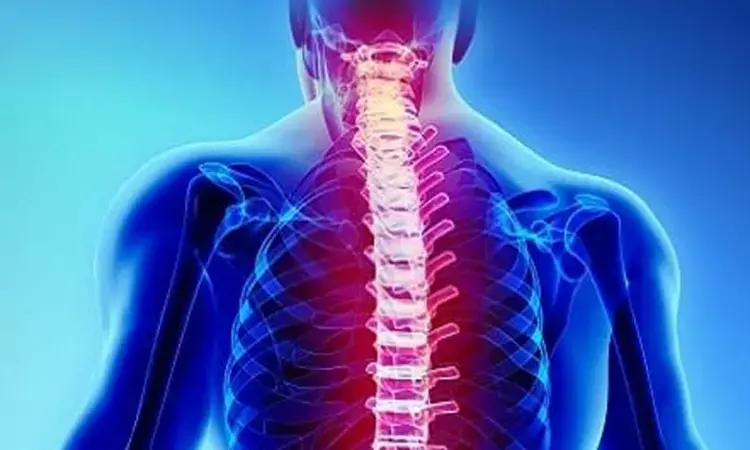- Home
- Medical news & Guidelines
- Anesthesiology
- Cardiology and CTVS
- Critical Care
- Dentistry
- Dermatology
- Diabetes and Endocrinology
- ENT
- Gastroenterology
- Medicine
- Nephrology
- Neurology
- Obstretics-Gynaecology
- Oncology
- Ophthalmology
- Orthopaedics
- Pediatrics-Neonatology
- Psychiatry
- Pulmonology
- Radiology
- Surgery
- Urology
- Laboratory Medicine
- Diet
- Nursing
- Paramedical
- Physiotherapy
- Health news
- Fact Check
- Bone Health Fact Check
- Brain Health Fact Check
- Cancer Related Fact Check
- Child Care Fact Check
- Dental and oral health fact check
- Diabetes and metabolic health fact check
- Diet and Nutrition Fact Check
- Eye and ENT Care Fact Check
- Fitness fact check
- Gut health fact check
- Heart health fact check
- Kidney health fact check
- Medical education fact check
- Men's health fact check
- Respiratory fact check
- Skin and hair care fact check
- Vaccine and Immunization fact check
- Women's health fact check
- AYUSH
- State News
- Andaman and Nicobar Islands
- Andhra Pradesh
- Arunachal Pradesh
- Assam
- Bihar
- Chandigarh
- Chattisgarh
- Dadra and Nagar Haveli
- Daman and Diu
- Delhi
- Goa
- Gujarat
- Haryana
- Himachal Pradesh
- Jammu & Kashmir
- Jharkhand
- Karnataka
- Kerala
- Ladakh
- Lakshadweep
- Madhya Pradesh
- Maharashtra
- Manipur
- Meghalaya
- Mizoram
- Nagaland
- Odisha
- Puducherry
- Punjab
- Rajasthan
- Sikkim
- Tamil Nadu
- Telangana
- Tripura
- Uttar Pradesh
- Uttrakhand
- West Bengal
- Medical Education
- Industry
Intersegmental fixation reliable for spondylolysis repair, Study says

Stability after sacrificing L5S1 segment motion temporarily can be achieved by intersegmental fixation, reports a recent study.
The research is published in the Journal of Orthopaedic Surgery and Research.
As per the investigators from the Department of Orthopedic, The Seventh Medical Center of Chinese PLA General Hospital, Beijing, China this technique is reliable for spondylolysis repair which has satisfactory symptom relief, high healing rate, low incidence of complications, and preserve a large part of ROM for fixed segment.
When symptomatic spondylolysis fail to respond to nonoperative treatment, surgical management may be required. A number of techniques have been described for repair by intrasegmental fixation with good results; however, there are still some problems.
Hence, Zhi-Cheng Zhang and colleagues reported a repair technique with temporary intersegmental pedicle screw fixation and autogenous iliac crest graft. The aim of present study was to assess the clinical outcomes of L5 symptomatic spondylolysis with this technique.
A retrospective analysis of 128 patients with L5 spondylolysis treated with this method was performed. According to CT scan, the spondylolysis were classified into 3 categories: line, intermediate, and sclerosis type.
The diagnostic block test of L5 bilateral pars defect was done in all patients preoperatively. The sagittal and axial CT images were used to determine the bone union. The healing time, complications, number of spina bifida occulta, Japanese Orthopedic Association (JOA) score, and VAS for back pain were recorded. After fixation removal, the rate of ROM preservation at L5S1 was calculated.
The following findings were highlighted-
a. There were 97 patients (194 pars) followed with mean follow-up of 23 months (range, 12–36 months).
b. The union rate of pars was 82.0% at 12 months and 94.3% at 24 months postoperatively.
c. Low back pain VAS significantly (P < 0.05) improved from preoperative mean value of 7.2 to 1.3 at the final follow-up postoperatively (P < 0.05).
d. JOA score increased significantly postoperatively (P < 0.05) with average improvement rate of 79.3%.
e. The rates of L5S1 ROM preservation were 79.8% and 64.0% after fixation removal at 1 and 2 years postoperatively.
f. There were 3 patients of delayed incision healing without other complications.
Therefore, this led the authors to conclude that "although the L5S1 motion segment was fixed temporarily with intersegmental pedicle screw, the segment obtained more stability to decrease hyperextension and rotation stress of L5 pars and improve the union rate, especially for patients of CT classification III, grade I spondylolisthesis, mild disc degeneration, and spina bifida occulta."
Dr. Nandita Mohan is a practicing pediatric dentist with more than 5 years of clinical work experience. Along with this, she is equally interested in keeping herself up to date about the latest developments in the field of medicine and dentistry which is the driving force for her to be in association with Medical Dialogues. She also has her name attached with many publications; both national and international. She has pursued her BDS from Rajiv Gandhi University of Health Sciences, Bangalore and later went to enter her dream specialty (MDS) in the Department of Pedodontics and Preventive Dentistry from Pt. B.D. Sharma University of Health Sciences. Through all the years of experience, her core interest in learning something new has never stopped. She can be contacted at editorial@medicaldialogues.in. Contact no. 011-43720751
Dr Kamal Kant Kohli-MBBS, DTCD- a chest specialist with more than 30 years of practice and a flair for writing clinical articles, Dr Kamal Kant Kohli joined Medical Dialogues as a Chief Editor of Medical News. Besides writing articles, as an editor, he proofreads and verifies all the medical content published on Medical Dialogues including those coming from journals, studies,medical conferences,guidelines etc. Email: drkohli@medicaldialogues.in. Contact no. 011-43720751


